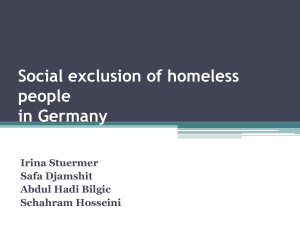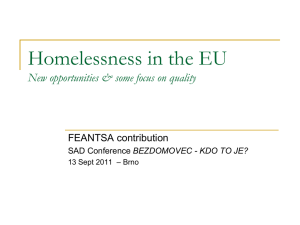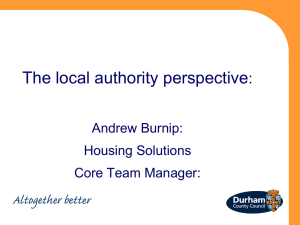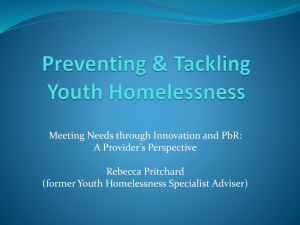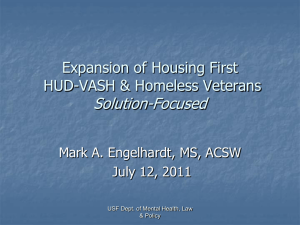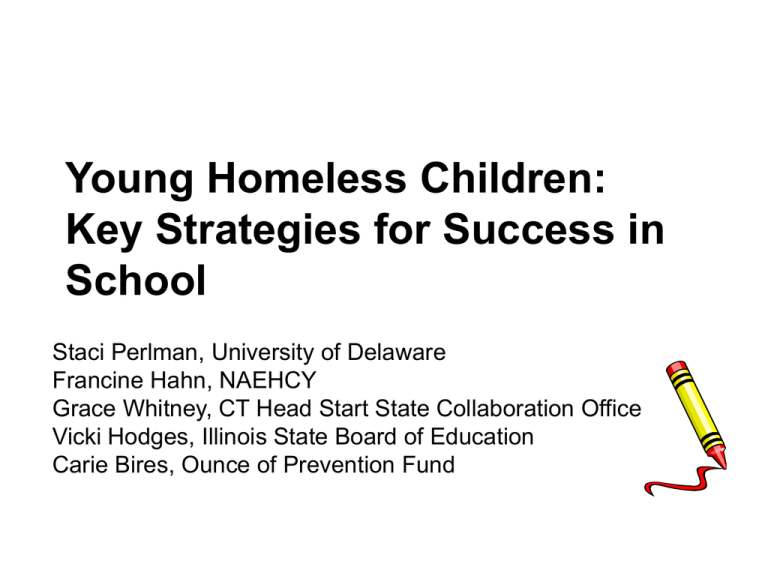
Young Homeless Children:
Key Strategies for Success in
School
Staci Perlman, University of Delaware
Francine Hahn, NAEHCY
Grace Whitney, CT Head Start State Collaboration Office
Vicki Hodges, Illinois State Board of Education
Carie Bires, Ounce of Prevention Fund
Session Overview
•
•
•
•
•
•
•
•
•
Impact of homelessness on young children
Relevant laws and regulations
5 minute break
Early childhood landscape and activity
Barriers and strategies
5 minute break
Scenarios and small group discussion
Reflection worksheet
Q and A
Dr. Staci Perlman
IMPACT OF HOMELESSNESS
ON YOUNG CHILDREN
National Picture of Homelessness
400000
350000
300000
250000
200000
150000
Homeless
100000
2005
2006
2007
2008
2009
2010
Ages of Children Experiencing
Homelessness
16%
31%
41%
12%
<1
1-5
6-12
13-17
And, if we turn the microscope up…
%
Homeless
(N = 906)
Infant
33
Toddler
33
Preschool
23
Elementary
11
Challenges Facing Families
Experiencing Homelessness
• Transience
• Schedules
• Histories of family violence/trauma
• Stressed attachments to caregivers
• Lack of access to food & health care
• Lack of developmentally-appropriate living spaces
• Invisibility
Top Five Reasons Why the Homeless System
Needs to be Concerned About Children & Youth
1.
Infants and toddlers have the highest r_____ of po_____ of any
age group in America
2.
Infants and toddlers in the U.S. are a "maj_____ mi______"
3.
The majority of m_____ of infants and toddlers are e________.
4.
Experiencing ____whelming or “t____" levels of s_____ harms
the ____ brain development of inf____ and tod_____.
5.
Current se_____ and su_____ for infants, toddlers, and their
parents reach only a ____ fraction of families who ____them
Child Development: 101
Development
Happens…
Synaptic Density
Prevalence & Co-Occurrence of Risks
Cohort
EH
Caucasian
11.3
3.7
African-American
68.0
91.0
Hispanic
16.2
5.3
Asian
3.7
0
Sex (male)
50.2
51.4
Poverty
54.7
71.1
Prenatal Care
32.8
52.2
Lead Exposure
25.9
39.5
Low Maternal Education
25.1
41.6
Substantiated Maltreatment
10.5
24.6
Unsubstantiated Maltreatment
11.8
18.6
Foster Care
5.2
21.4
Emergency Housing (EH)
12.0
-
23% Housed NO Risks
3% EH had NO Risks
20% Housed > 3 Risks
50% EH > 3 Risks
Poor Health
Poor Mental Health
Children who
have
experienced
homelessness
Developmental
Delays
School
Problems
Academic
Achievement
Social
Skills
DNA does not control our destiny
We can do
something
about
this…
The good news is…
Developmental
science tells us
what works to
promote early
development!
Early Childhood Services
Parenting
Supports
Quality
Early
Education
Home
Visiting
Early
Intervention
Quality
Child Care
Early Head
Start / Head
Start
Reflection 1
Take a moment to reflect on the
impact of homelessness on young
children and their families and the
relevance of this information to your
work. Jot down a phrase or two to
record your thoughts.
Francine Hahn
LAWS AND
REGULATIONS
McKinney-Vento and Preschool
• School district McKinney-Vento liaisons must
ensure that families and children have access
to Head Start, Even Start, and other public
preschool programs administered by the LEA
• State McKinney-Vento plans must describe
procedures that ensure that homeless children
have access to public preschool programs
• School districts are required to remove
barriers to the enrollment of homeless
children, including preschool children
HEARTH Act: Who is Covered?
• Homeless Emergency Assistance and Rapid
Transition to Housing (HEARTH)
• The Continuum of Care agencies
• Shelter + Care providers
• Emergency Solutions Grants
• Supportive Housing Project
• To find your Continuum of Care, go to
www.hudhre.gov
HEARTH: Definition of Homelessness
• Families must meet criteria before M-V definition
applies:
– Do not otherwise qualify
– Homeless for 60 days or more
– Moved at least 2Xs in 60 days
– Expected to remain homeless
• Definition of chronic homelessness includes
families where a head of household has a
disability.
HEARTH Act:
HUD Assurances Related to Children
Shelters and service providers must:
• Establish policies and practices consistent with
M-V and they cannot interfere with a child’s
education
• Entities that provide housing or services to
families must identify a point person who is
responsible for ensuring all children are enrolled
in school and connected to services, including
early childhood programs such as Head Start,
Part C of the Individuals with Disabilities Act, and
McKinney-Vento education services.
Hearth Act:
HUD Assurances Related to Children
• Continuum of Care and HUD-funded homeless
service programs
• Continuums must:
– Collaborate with school districts to identify
and inform homeless families of M-V
education rights
– Must consider child’s educational needs when
placing in shelter and/or providing services
How Can Providers Meet the
HEARTH Education Requirements?
•
•
•
•
•
•
Assess education needs at intake
Inform families of education rights and options
Assist discussion regarding school selection
Connect families with schools/education programs
Advocate for enrollment and access to services
Collaborate with school districts around provision of
supportive services
• Monitor attendance and achievement
• Ensure shelter policies do not create barriers to
education
• Discuss education as part of exit planning
Head Start &
Early Head Start
• Categorical eligibility
• HS & EHS must ID and prioritize for
enrollment
• Allow to attend while waiting for documents
• HS & EHS must collaborate with school
districts
• Every state has Head Start Collaboration
Office
IDEA Part B: Child Find
• Evaluations must be completed within 60 days from
parent’s request
• If family changes LEAs during evaluation period the
same 60 day time frame applies to new LEA
• Assessments must be coordinated between former
LEA and receiving LEA
• When homeless child has IEP and enters new LEA,
the IEP must be implemented
• If LEA is in a new state, the IEP must be
implemented while the school conducts its
evaluation.
IDEA Part C: Infants & Toddlers
• Homeless infants & toddlers 0-3 must be
identified and served
• Homeless family shelters are a primary
referral source
• 7 day referral time frame
• States can opt for screening process to
determine if there is suspected disability
• At screening level parents must receive
notice of right to request an evaluation
IDEA Part C: Final
Regulations
• Enhanced due process option: lead
agency may establish procedure
allowing aggrieved party at hearing to
request reconsideration (appeal)
• Copies of evaluations, assessments
and IFSPs must be provided to parents
at no cost
Child Care Subsidy
• Child Care Development and Block
Grant Act of 2015
• Provide grace period for homeless
children to become up-to-date on
immunizations
• Allow immediate enrollment w/o all
required documents
• Structure co-payments on sliding
scale fee basis
• Lead agency must coordinate w/ M-V
school liaison and other community
providers
Grace Whitney and Carie Bires
EARLY
CHILDHOOD
LANDSCAPE
Early Care and Education Landscape
•
•
•
•
•
•
•
•
Child Care
Individuals with Disabilities Education Act
State Pre-Kindergarten Programs
Head Start & Early Head Start
Home visiting
Federal initiatives
State Advisory Councils
Early childhood collaborations
Child Care Development Fund:
the Basics
• Primary Federal funding source for subsidized child care;
supplemented with state funds and TANF
• Goals of CCDF: (1) Promote self-sufficiency by making
child care more affordable to low-income parents; (2)
Foster healthy child development and school success by
improving the quality of child care
• 1.7 million children monthly
• CCDF designates set asides for quality initiatives and
services for infants and toddlers
• States must submit a biennial CCDF plan
CCDF:
Family Eligibility
• CCDF serves children under the age of 13; up to age
19 for children with disabilities
• Children must be citizens or qualified aliens
• Parents must be working or participating in education
or training activities
• Family income must be below 85% SMI
• Protective services category
• Priority required for children with special needs or very
low income families
• States have a lot of discretion
CCDF: Provider Eligibility
• CCDF regulations define four types of child
care: center-based, family child care, group
home child care, and in-home care
• Providers must be licensed/regulated under
State/Tribal law; or must be legally exempt
from regulation
• Providers must meet basic health and safety
requirements
• Because licensing/regulation requirements
vary by state, so do eligible providers
CCDF: Payment
• Certificate: subsidy issued
directly to a parent
• Contract: States can
contract with providers for
child care slots that are
then available to children
participating in CCDF
• Parent co-pays
CCDF: Finding Child Care
• Child Care Resource and Referral (CCR&R)
– CCDF requires coordination of ALL child care through
CCR&R
– Resource to help families find child care
– Consumer education, provider training, data
collection, administer subsidies
• Quality Rating and Improvement System (QRIS)
– System to assess, improve, and communicate the
quality of early care and education programs
– Operating in nearly half of all states
– www.qrisnetwork.org
Increasing Access to Child Care
States can:
• Cover homeless children under the
“protective services category”, and
waive work/school requirements
• Offer priority access
• Allow for a period of job search
• Waive co-payments for families at or
below poverty level
• Exempt housing assistance from
income determination
• Use grants or contracts to build
supply for vulnerable populations
IDEA Parts B & C
• Federal funds to states under Individuals with
Disabilities Education Act (IDEA)
– Part B – Preschool Special Education ages 3-5
– Part C – Infants and Toddlers
• Uses McKinney-Vento definition of homeless
• Provides for identification, location, evaluation
and education of children with disabilities who
are experiencing homelessness
– Individualized Plan: IFSP/ISP
– Home-based, classroom & consultation models
– Goal of mainstreaming, integrating into ECE
State Pre-K
Programs
• State funding of preschool services for 4-yearolds or for 3- and 4-year-olds
• State agencies provide leadership and provide
funding to local school districts
– Both school based and community providers
– Both targeted and universal designs
– State Cabinets and integrated state agencies and
departments
– Local councils and community partnerships
• Most states now have some type of state pre-k
system; federal funds coming
Head Start: Basic Overview
• Created under LBJ’s “War on Poverty” ~ 1965
– Early Head Start – pregnant women and
children ages birth to 3 years
• Less than 5 % of those eligible
– Head Start – preschool-aged children 3-, 4and 5-year-olds
• Less than 50% of those eligible
• Intended to achieve 2 primary goals:
– break the cycle of poverty
– empower low-income families
– school readiness**
Head Start: Basic Overview
Comprehensive Services mandated for children
and families – a unique feature
– Health, mental health, dental and nutrition
– Education and special education/disabilities
• Approximately 20% of children with IEPs served by
Head Start
– Family support thru Family Partnership
Agreements, parent
involvement/governance, fatherhood
initiatives, etc.
• 20-25% of Head Start staff current/former parents
– Community partnerships
Head Start: Basic Overview
Head Start Program Options
◦
◦
◦
◦
◦
◦
Full-day/full-year
School day/school year
Part day/part year
Home-based Model
Family child care home (Home Start)
Locally designed option
Head Start Act of 2007 allows programs to
explore changing program designs to meet
changing community needs.
Head Start: Basic Overview
• Enrollment primarily based on federal poverty
• Not less than 10% of each HS & EHS program’s
enrollment must be children with special needs
• The following families are categorically eligible for
HS:
– *families receiving public assistance (e.g. TANF)
– *children in foster care
– *children experiencing homelessness
(McKinney-Vento definition)
Children in Head Start
Head Start: A Perfect Match for
Homeless Families
Head Start provides comprehensive services that
homeless children may not otherwise receive
The Head Start focuses on entire family means
parents receive assistance in reaching their goals
Community partnerships put Head Start in an excellent
position to work with all agencies serving homeless
families
Head Start programs are required to identify and
prioritize homeless children for enrollment; allow
homeless children to enroll while required paperwork is
obtained; and coordinate with LEA liaisons and other
community agencies
Early Childhood Home Visiting
• Home visiting programs match at-risk parents with
trained professionals who provide information,
advice, and support during pregnancy and
throughout the first few years of the child’s life
• Funded with federal, state, and private dollars
• Targets pregnant women, families with young
children
• Multiple evidence-based models: Parents as
Teachers (PAT), Healthy Families America (HFA),
Nurse-Family Partnership (NFP), Home Instruction
for Parents of Preschool Youngsters (HIPPY)
Proven Benefits of Home Visiting
• Improved prenatal, maternal, and
child health outcomes
• Enhanced social-emotional and
language development
• Supports cognitive and physical
development
• Reduces child maltreatment and
injury
• Increased school readiness
• Improved coordination with
community resources
How Does Home Visiting Support
Homeless Families?
• Addresses and buffers negative
impacts of homelessness
• Helps families build resilience and
strengthen family functioning
• Mobile service: visits can take
place in families’ homes, in shelter
programs, or in other settings
• Connects families to other
community resources
Federal Initiatives
• Race to the Top-Early Learning Challenge
(RTT-ELC)
• Early Head Start-Child Care Partnerships
(EHS-CCP)
• Preschool Development/Expansion
Grants
• Maternal Infant Early Childhood Home
Visiting Program (MIECHV)
State Advisory Councils
• Charged with developing a high-quality,
comprehensive system of early childhood
development and care
• Ensure statewide coordination and collaboration
among the wide range of early childhood programs
and services in the State, including child care, Head
Start, IDEA preschool and infants and families
programs, and pre-kindergarten programs and
services
• Can be a great opportunity to influence early
childhood policies, practices, and investments in
your state
Early Learning Coalitions
• Early Learning Coalitions at state, county
and/or community levels
• Wide variety of participation and funding
support
• Homeless service providers and liaisons
should consider attending to create
connections and learn local resources
• The Foundation for Early Learning guides the
coalition-building process –
www.earlylearning.org/grantmaking/coalitions
Early Care & Education
Landscape: A Grid
Work with someone sitting near you to complete
the Early Care and Education Infrastructure in
My State/ Community for either the state or
local level
If you cannot complete a cell, use the Early
Care and Education Resource List to find a
resource for obtaining the name, contact
information you need to complete our grid.
You will have 5 minutes for this activity.
Reflection 2
Take a moment to reflect on the various
resources that support early learning.
Which do you currently partner with
and who might you become more
familiar with in the future? Jot down a
phrase or two to record your thoughts.
Vicki Hodges
BARRIERS AND STRATEGIES
Barriers to Early Childhood Programs
for Families Experiencing Homelessness
•
Lack of Awareness
– Families and agency staff unaware that homeless children are
prioritized for EC programs
– Head Start programs unaware of definition of homelessness
– MV liaisons may not know “lay of the land” of ECE
• Lack of available slots
– For eligible children, especially Infants and Toddlers, including
those who are homeless
• Lack of capacity for McKinney-Vento liaisons and Head
Start programs to do outreach and targeted assistance
Barriers to Early Childhood Programs
for Families Experiencing Homelessness
• High Mobility
• Lack of Transportation
• Lack of documentation for
enrollment
• School selection
Removing Barriers:
Strategies for Awareness and
Identification
• Head Start programs/school districts
– incorporate questions on housing status on applications
• McKinney-Vento liaisons
– Participate in community based and cross-agency events
– Inquire about young siblings of school-aged children
• Homeless service providers
– Document ages of all children at intake
– Make referrals to Head Start, ECEAP, and other ECE
programs
Removing Barriers:
Strategies for Awareness and Identification
•Early Childhood programs
–Include information to staff on how to recognize homelessness
•Shelters
–Ensure that young children are assessed for developmental
delays
•New HUD Contacts
–Train on assessment programs, e.g. Ages and Stages, Early
Intervention programs, and Special Education Child Find
•Provide indicators of potential developmental delays
Removing Barriers:
Strategies for Identification and
Responding to Mobility
• Obtain parental consent for release of information
from providers or liaison
– to share information between agencies
– To obtain new addresses to be able to continue to provide
services when families move
• Develop joint procedures to serve highly mobile
children
– To expedite services
– To provide continuous services to highly mobile children
Removing Barriers:
Strategies to Expedite Access
• Liaisons and homeless service staff
– provide and assist with completing Head Start applications to
identified families
• Expedite records
– e.g. liaisons can get immunization records, etc. for young
siblings of school-aged children
• Develop joint or streamlined procedures and forms
(e.g. housing intake forms)
Putting it All Together:
Strategies for Collaboration
• Head Start & ECEAP Programs could adopt a number of
strategies to reach homeless families
– Develop relationship with K-12 Homeless Liaison
– Assign staff member to be the liaison with local homeless
shelters/service providers
– Training for family advocates to identify homeless families
throughout the year
– Conduct presentations and visits to and from homeless shelters
and advocacy groups regarding services available
– Establish connections with food banks, churches, health
departments, and housing groups within communities
Reflection 3
Take a moment to reflect on the various
strategies that can be used to overcome
barriers and new approaches you might
try in your program and community. Jot
down a phrase or two to record your
thoughts.
Carie Bires
SCENARIOS AND DISCUSSION
Scenarios and Discussion
In your small group,
read through the
scenarios on your
table and answer the
question: What would
you do?
Reflections to Actions
1. Using your three reflections on the work
we’ve done today, take a moment to
record an action or two that you will take
when you return to your program
2. Share your Action Plan with another
person, or two, or three.....
Resources - ECLKC
Office of Head Start – Early Childhood Learning and
Knowledge Center – Search ECLKC - enter “homelessness”
Go to: Training and Technical Assistance System:
http://eclkc.ohs.acf.hhs.gov/hslc/tta-system
From there, go to Parent, Family, and Community
Engagement
From there, go to Crisis Support
From there, go to Homelessness Online Lessons
Recent ACF Efforts
Building Partnerships to
Address Family
Homelessness
Promising Practices for Children
Experiencing Homelessness: A
Look at Two States
ACF Efforts in Review
Early Childhood Self Assessment for
Family Shelters
General Resources
• National Association for the Education of Homeless Children and
Youth
– http://www.naehcy.org
• National Center on Homeless Education
– http://www.serve.org/nche
• National Early Childhood Technical Assistance Center
– http://www.nectac.org
• Horizons for Homeless Children
– http://www.horizonsforhomelesschildren.org
• Washington State Association of Head Start & ECEAP
-- http://wsaheadstarteceap.com
• Parent Training and Information Centers
– http://www.taalliance.org/centers/index.htm
– (888) 248-0822
Policy Resources
• NAEHCY: www.naehcy.org, Barbara Duffield,
bduffield@naehcy.org, 202.364.7392
• National Center on Homeless Education: www.serve.org/nche
• National Law Center on Homelessness & Poverty:
www.nlchp.org
• Zero to Three, http://www.zerotothree.org
• National Head Start Assoc., http://www.nhsa.org/
• National Center for Children in Poverty, http://nccp.org/
• Institute for Children, Poverty & Homelessness,
http://www.icphusa.org/
• Center for Law and Social Policy, http://www.clasp.org/
• Center on Budget Policy and Priorities, http://www.cbpp.org/
Contact Information
Carie Bires, MSW
Policy Manager
Ounce of Prevention Fund
33 W. Monroe, 24th Floor
Chicago, IL 60606
309-261-3138
cbires@ounceofprevention.o
rg
Francine K. Hahn, J.D.
NAEHCY, Board of Directors
Baltimore, MD
Phone: 443-756-7451
fhahn1229@gmail.com
Staci M. Perlman, MSW, PhD
Assistant Professor
University of Delaware
Human Development and Family Studies
Delaware Education Research &
Development Center
106 Alison Hall
Newark, DE 19716
302.831.4724
sperlman@udel.edu
Vicki J. Hodges
Principal Consultant
Illinois State Board of
Education
100 N. First
Springfield, Il. 62777
217-782-8535
vhodges@isbe.net
Grace C. Whitney, PhD, MPA, IMH-E(IV)
CT Head Start State Collaboration Office
CT State Department of Education
165 Capitol Avenue
Hartford, CT 06106
Phone: 860-713-6767
Email: grace.whitney@ct.gov





